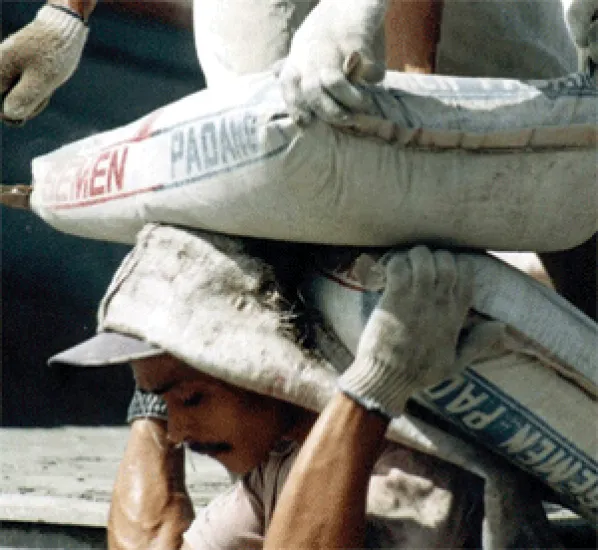After years of hand wringing over its Indonesian investment, Mexican cement maker Cemex has finally signaled an exit from the country – hopefully with some lessons learned that it can apply elsewhere.
| A Semen Gresik worker in Indonesia unloads bags of cement. |
Cemex said in early May that it's set to sell a 24.9% stake in Indonesian cement company Semen Gresik for $337 million to a local conglomerate called the Rajawali group. It's short of the $500 million press reports said the company wanted, but more than the roughly $200 million it paid for the shares since 1998. Locals are rejoicing at seeing the back of a company they regarded as an intruder that threatened their way of life. Cemex is glad to be out and focus on bigger targets. Investors also celebrated the exit, sending Cemex shares up more than 5% from the time the first rumors surfaced that a departure deal from Indonesia was imminent.
Bond Snodgrass, managing director of Snodgrass Research, an independent firm based in Mexico City, sums the Cemex departure up like so: "Cut your losses, get rid of a headache. Concentrate on creating value elsewhere." Elsewhere could include China or India, where Cemex has had staff for years looking for opportunities. The lessons learned in Indonesia and since could prove valuable in other parts of Asia, and also partially explain the company's patience in identifying targets. Going forward, Cemex may decide, for example, to avoid countries – like Indonesia – that are ranked lower on Transparency International's Corruption Perceptions Index than Afghanistan and the Congo.
Silence is Golden
Cemex executives are refusing to comment, continuing their policy of silence on the sore subject. "Our position is the same. We are in conversations with the government to see what is the best thing for Cemex," Hector Medina, executive vice president of planning and finance, told participants in the company's first quarter earnings conference call. Analysts are writing off Cemex's Indonesia snafu as a lesson learned, a risk taken and a savvy exit from an investment gone wrong. Semen Gresik had dogged the company for years, raising questions about its ability to make wise decisions. However, the biggest take away point appears to be not to buy a minority stake when the government still controls the company. In retrospect, the venture has been a cheap lesson for Cemex along the road to becoming a global giant worth $25 billion. When Cemex decided to dabble in Indonesia, it was new to investing abroad and anxious to do so. In 1998, Cemex was the tenth largest cement producer in the world and operated in just nine countries. Today it has operations in more than 50 countries.
"Over the years, it has developed tremendous experience dealing in different countries and different operating environments. They will be doing so now with much more experience," says Felix Boni, an equity analyst at Scotiabank Inverlat brokerage in Mexico City.
Still, the experience has made Cemex cautious and it has been particularly shy of large markets, anxious to make sure its entry into Brazil, China, India and Russia does not go the same way as Indonesia. If it succeeds in those markets, the lesson will have been worthwhile. Innocent optimism, bad timing and even worse luck played against Cemex. Back in 1998, it was smiles all around as Cemex bought 14% of PT Semen Gresik, the largest cement producer in Indonesia, with an option to buy a majority stake from the government at a later date. The government was in the midst of an IMF-sanctioned effort to privatize state-owned industries after the economy collapsed, contracting 13% in that year alone. Cemex, itself a veteran of currency meltdowns, saw Indonesia as a place to expand. "Indonesia is an attractive market for Cemex and offers favorable long-term growth prospects. This investment is congruent with our strategy of prudent international diversification," Medina said at the time, in a press statement. With its crony capitalism and dominant market players, the Asian country had a Latin American feel to it.
The IMF program and its austerity measures, especially the reduction in government spending on social programs as jobs melted away and salaries plummeted, quickly drew critics. Such measures have given privatizations in Indonesia a Washington stamp that has made them unpopular. To make matters worse, competitors like France's Lafarge and Switzerland's Holcim are still in Indonesia, having bought wholly private companies. Cemex hasn't bought a minority stake anywhere since entering Indonesia, suggesting it is less trusting than it used to be of contracts.
Cemex has financed its worldwide expansion with cash generated at home where it dominates a market with some of the highest cement prices in the world. Regulators have so far proved toothless and the Mexican government repulsed a recent attempt to import cement into the country. On the surface, navigating politics and economics appeared similar in Indonesia. And the target was tempting.
PT Semen Gresik was already the dominant player in its national market. As well as its main unit at Gresik near Surabaya in eastern Java, it also controlled two subsidiaries: PT Semen Padang in Sumatra and PT Semen Tonasa in Makassar, Sulawesi. The subsidiaries gave Semen Gresik a strong national role in a market that saw annual growth rates in cement sales of 6% and above, despite the grinding economic crisis. The group produces 16 million tons a year of cement and controls about half of the market.
Cemex's efforts to control Semen Gresik faltered when protests emerged against foreign ownership in Semen Padang from the people of West Sumatra. To them, Semen Padang was a part of the city's heritage and, claiming that it was built on ancestral land, locals in Padang demanded the company be separated from Semen Gresik. At one stage in 2001, just as the government was readying to sell its stake to Cemex, protestors kidnapped the board of directors, demanding that they sign a statement rejecting the deal. They signed, throwing the deal into jeopardy.
The government realized it was between a rock and a hard place. Then minister for state-owned enterprises, Laksamana Sukardi, tried a persuasive approach. Noting that the government needed to raise nearly $750 million through the privatization of state-owned companies, he said "this is about the interests of the nation...I hope that they [the people of Padang] can understand that." The people of Padang didn't understand, while in Makassar there were similar rumblings about selling-off Semen Tonasa. There was talk of a spin-off of the two companies, but no action.
Indonesia's senior economics minister, who goes by the single name of Boediono, admitted in April that the issue of privatization remains a tricky one in Indonesia. "We have not come up with a solid privatization program for state-owned enterprises," Boediono told foreign journalists. "The political debate is very intense."
Culture Clash
While the government clearly fell short of meeting its obligations to Cemex, many believe that Cemex itself has to take some of the blame for the failure to produce a happy ending. One Indonesian official who was closely involved in dealings with the Mexican giant, and who asked not to be named in this story, says Indonesians were appalled by the arrogance of Cemex representatives. "Look at the structure of their organization," he says. "They never even had an Indonesian human resources manager, they flew someone in from Mexico. They applied the tactics they had used in Latin America, what they called post-merger integration, which meant a complete takeover by their own people. I have no idea how they managed to get work permits for so many people, everyone was Mexican or Spanish.
Visitors to Cemex's offices in the stock exchange building rarely met any Indonesians. Local staff members they did employ were parked in a room with nothing to do. When Cemex officials interacted with Indonesians, they tended to upset them. "I tried to suggest to one of their lawyers that they needed to be more sensitive to local cultures," says a one-time advisor, who also asked not to be named. "He told me that they had the money so it was the Indonesians who needed to understand Mexican culture."
Indonesian culture values polite behavior above all. Cemex executives ignored any attempt to blend in, and shouted at people, these insiders say. Quite a contrast from the accolades the company consistently wins in the investment world. Chief executive Lorenzo Zambrano is often painted as a visionary who took Cemex outside Latin America and paved the way for other corporations in the region to follow the global path.
"Cemex has done a fabulous job. It executes well year after year, It has a proven track record at integrating large acquisitions," says Matthew Hickman, director of Latin American Equities for Credit Suisse Asset Management.
Drop in the Bucket
Semen Gresik, announcing 2005 figures last April, reported audited net profit of $116.2 million, almost exactly double the previous year's figure, on strong sales growth. While 2006 is turning out to be a slower year after two rounds of fuel price rises last year dampened demand, the company is still tipping a further 25% growth on revenue of close to $1 billion. It is planning a new East Java plant to serve the national market.
The company controls 45% of the Indonesian market, and with plans for a major infrastructure drive and hopes that the economy will be out of the doldrums caused by the fuel price rises by year-end, Cemex could have continued to reap solid returns on its investment. However, given Cemex's net profit last year of $2.1 billion, the Indonesia operation will not be sorely missed.
An advisor to Holcim, who asked not to be named in this story, says a lot of the difference between the Swiss company's success and Cemex's failure was a matter of style. "Holcim came in very quietly and retained most of the Indonesian executives. They didn't make any of the noise that Cemex did."
Back in Monterrey, Cemex executives have shown restraint and rarely even imply a criticism of the Indonesian government. Instead, they have quietly filed a suit with the International Center for Settlement of Investment Disputes. Arbitrators are due to meet in July to decide the case.
Now, they may not have to.






